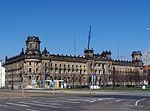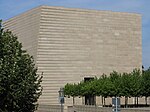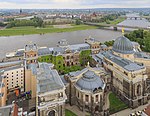Kaiserpalast

The Kaiserpalast was a five-storey neo-Baroque building in Dresden, which stood on the north side of the Pirnaischer Platz between Moritzring and Amalienstraße. It was built between 1895 and 1897 as the Geschäftshaus Ilgen by the architects Schilling und Graebner for the businessman Hermann Ilgen. It had one tower and on its gable were statues by Hans Hartmann-MacLean. Its porch had a huge window designed by Josef Goller. The ground and first floors were faced with sandstone and the other floors' facades were plastered. It housed a restaurant and a bank. It was destroyed in February 1945 during the bombing of Dresden and the remaining ruins were demolished in 1951.
Excerpt from the Wikipedia article Kaiserpalast (License: CC BY-SA 3.0, Authors, Images).Kaiserpalast
Pirnaischer Platz, Dresden Pirnaische Vorstadt (Altstadt)
Geographical coordinates (GPS) Address Nearby Places Show on map
Geographical coordinates (GPS)
| Latitude | Longitude |
|---|---|
| N 51.049444444444 ° | E 13.745555555556 ° |
Address
Pirnaischer Platz
Pirnaischer Platz
01069 Dresden, Pirnaische Vorstadt (Altstadt)
Saxony, Germany
Open on Google Maps









